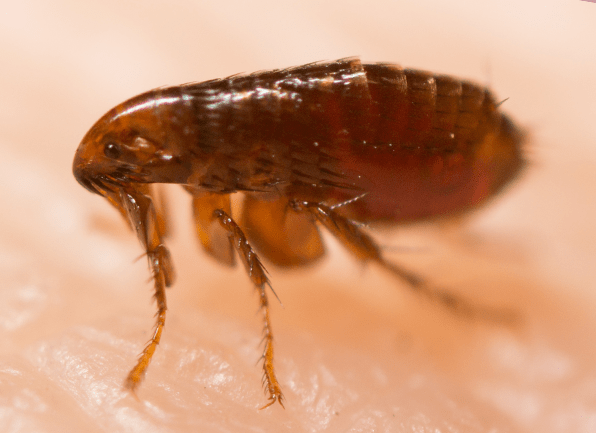Exterminate Fleas from Home Fast
If you have a furry friend at home, you might have encountered these pesky little insects: fleas. Fleas are tiny parasites that feed on the blood of animals and sometimes humans. They can cause itching, irritation, allergies and even diseases. In this article, we’ll answer some common questions about fleas and how to get rid of them.

What are Fleas?

Fleas are wingless insects that belong to the order Siphonaptera. They have a flattened body, long legs and a mouthpart that can pierce the skin and suck blood. They are very agile and can jump up to 200 times their body length. There are more than 2,000 species of fleas, but the most common ones that affect pets and humans are the cat flea, the dog flea and the human flea.
What do fleas look like?
Fleas are very small, ranging from 1 to 3 mm in length. They are usually brown or reddish-brown in color. They have a hard exoskeleton that protects them from being crushed. They also have sensory hairs and antennae that help them detect their hosts.
Can humans get fleas?
Yes, humans can get fleas, but it is not very common. Most fleas prefer to feed on animals with thicker fur or feathers, such as cats, dogs, rabbits, rodents and birds. However, some fleas can bite humans if they are hungry or if their preferred hosts are not available. Human fleas are rare nowadays, but they used to be a major problem in the past, especially during the plague
Do fleas bite humans?
Fleas can bite humans and cause itching, redness and swelling. Flea bites are usually found on the lower legs, ankles and feet, where the fleas can easily access the skin. Some people may have allergic reactions to flea bites and develop hives, blisters or rashes. Flea bites can also become infected if scratched or not treated properly.
What Do Flea Eggs Look Like?
Flea eggs are oval-shaped and white or transparent in color. They are about 0.5 mm in size and can be easily mistaken for dust or dandruff. Flea eggs are laid by female fleas on the fur or feathers of their hosts, but they can also fall off and contaminate the environment.
Do fleas carry diseases?
Fleas can carry diseases that can affect both animals and humans. Some of the diseases that fleas can transmit include:
– Plague: This is a serious bacterial infection that can cause fever, chills, headache, swollen lymph nodes and sometimes death. It is caused by the bacterium Yersinia pestis, which is carried by rodent fleas and transmitted to humans through bites or contact with infected animals.
– Typhus: This is another bacterial infection that can cause fever, headache, rash, muscle pain and sometimes death. It is caused by different types of bacteria from the genus Rickettsia, which are carried by various fleas and transmitted to humans through bites.
– Cat scratch disease: This is a mild bacterial infection that can cause fever, swollen lymph nodes and sometimes skin lesions. It is caused by the bacterium Bartonella henselae, which is carried by cat fleas and transmitted to humans through scratches or bites from infected cats.
– Tapeworms: These are parasitic worms that can live in the intestines of animals and humans. They can cause abdominal pain, diarrhea, weight loss and sometimes complications. They are caused by different types of tapeworms from the genus Dipylidium or Taenia, which are carried by fleas and transmitted to humans when they accidentally swallow infected fleas.
Do fleas fly?
No, fleas do not fly. They do not have wings or any other means of flying. They rely on their powerful legs to jump from one host to another or from one place to another.
How long do fleas live without a host?
Fleas can live without a host for several weeks or months depending on the temperature and humidity of their environment. Flea eggs can survive for up to a year in favorable conditions before hatching into larvae. Flea larvae can survive for up to two weeks before spinning cocoons and becoming pupae. Flea pupae can remain dormant for up to six months before emerging as adult fleas when they sense a potential host nearby.
How do I get rid of fleas in the house fast?
Getting rid of fleas in the house fast requires a combination of methods that target both the adult fleas and their eggs, larvae and pupae. Some of the steps you can take include:
– Vacuuming: This is one of the most effective ways to remove fleas and their eggs from carpets, rugs, furniture, bedding and other surfaces. Vacuum thoroughly and frequently, especially in areas where your pets spend time. Dispose of the vacuum bag or empty the canister outside after each use.
– Washing: This is another way to kill fleas and their eggs on fabrics, such as clothing, bedding, curtains and pet accessories. Wash everything in hot water and dry them on high heat. You can also add some vinegar or bleach to the water to enhance the effect.
– Spraying: This is a way to kill fleas and their eggs on hard surfaces, such as floors, walls, baseboards and cracks. You can use a flea spray that contains insecticides, such as pyrethrins or permethrin, or natural ingredients, such as peppermint oil or diatomaceous earth. Follow the instructions on the label and apply the spray carefully and evenly. Avoid spraying on food, water, plants or pets.
– Treating: This is a way to kill fleas and their eggs on your pets, such as cats and dogs. You can use a flea treatment that contains insecticides, such as fipronil or imidacloprid, or natural ingredients, such as neem oil or garlic. Follow the instructions on the label and apply the treatment to your pets’ skin or fur. Avoid treating pregnant, nursing or sick pets.
– Preventing: This is a way to prevent fleas from coming back to your house and your pets. You can use a flea prevention product that contains insecticides, such as selamectin or nitenpyram, or natural ingredients, such as cedar oil or rosemary. Follow the instructions on the label and apply the product to your pets’ skin or fur. Avoid using more than one product at a time. You can also keep your house clean and tidy, seal any gaps or holes where fleas can hide, and avoid contact with stray animals or wildlife.
Fleas might be tiny, but they sure can be a big nuisance. Armed with this knowledge, you’ll be well-equipped to tackle these pests head-on. Remember, persistence is key, and with a little patience and effort, you can reclaim your home from these blood-sucking invaders. Happy bug-busting!